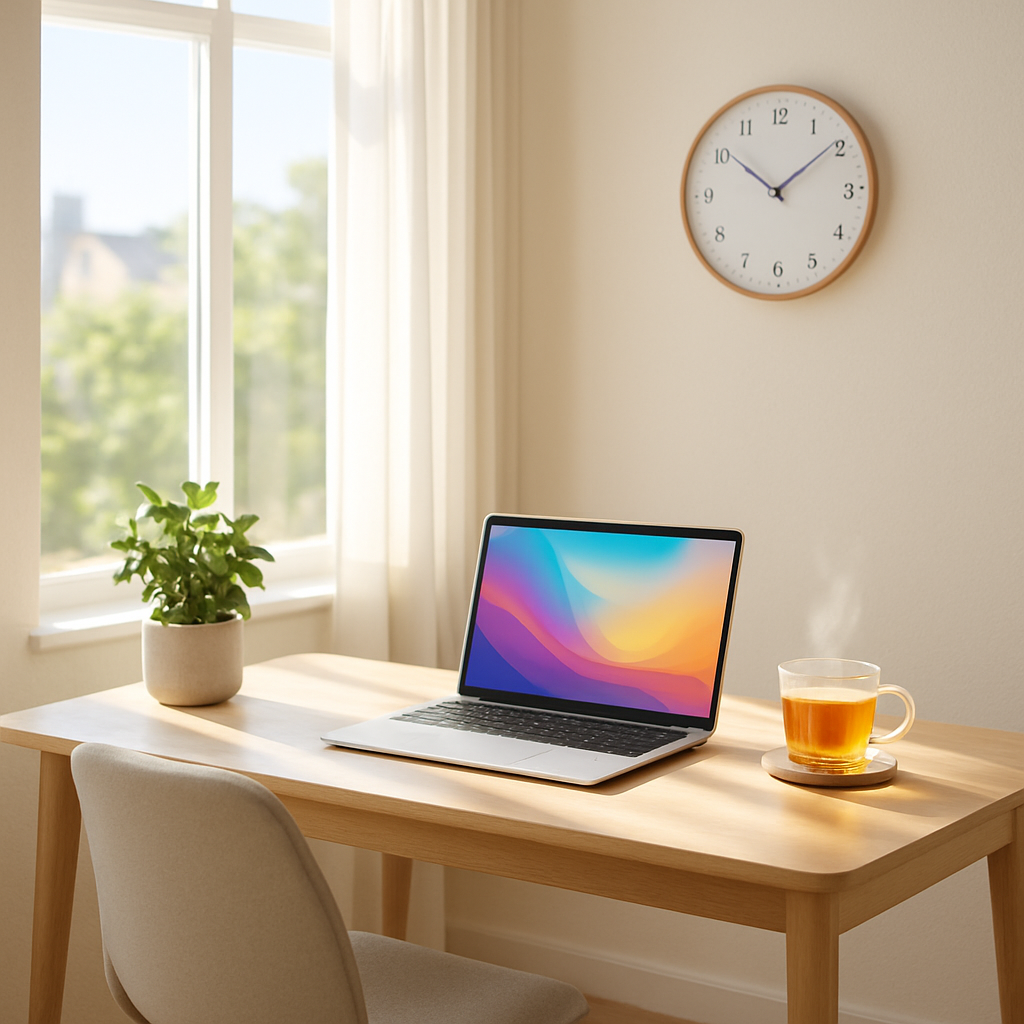
5 Unexpected Ways to Boost Your Productivity at Home
Working from home has become standard practice for many of us, but that doesn’t mean we’ve all figured out how to do it effectively. Despite our best intentions, productivity can take a nosedive when surrounded by household distractions, comfortable couches, and no supervisor looking over our shoulder.
After struggling with my own work-from-home efficiency for years, I’ve discovered some surprising productivity boosters that aren’t found in typical advice articles. These aren’t your standard “make a to-do list” or “wake up early” tips – they’re unexpected approaches that actually made a difference for me when nothing else seemed to work.
The Productivity Paradox
The most counterintuitive productivity hack I’ve found? Working less. Yes, you read that right.
Many of us fall into the trap of thinking productivity means cramming every minute with work. We push through fatigue, skip breaks, and pride ourselves on “powering through.” This approach usually backfires spectacularly.
Research from Microsoft Japan found that implementing a four-day workweek led to a 40% increase in productivity. Workers accomplished more in less time because they were fresher, more focused, and motivated to complete tasks efficiently.
I tried a modified version of this approach at home. Instead of working continuously for 8+ hours, I now work in 90-minute focused blocks followed by genuine breaks. Not just scrolling social media, but actually stepping away from my workspace completely.
Last Tuesday, during a particularly challenging writing project, I hit a wall after two hours. Rather than forcing myself to continue staring at my screen (my old approach), I took a 30-minute walk around my neighborhood. When I returned, I finished the piece in half the time it would have taken me had I just kept pushing through my mental fog.
Try scheduling deliberate “not working” periods in your day. Block off 30 minutes after lunch to read a novel, take a walk, or simply stare out the window. Your brain needs these periods to process information and make new connections.
- Strategic background noise
The perfect silence many productivity experts recommend? It might actually be hurting your focus. A completely quiet environment makes random noises (the neighbor’s dog, a car horn) much more distracting.
Studies from the Journal of Consumer Research found that moderate ambient noise (around 70 decibels – think coffee shop level) enhances creativity and productivity for many people. This background noise creates just enough distraction to prevent your mind from hyper-focusing on itself.
I’ve experimented with different sound environments and found that rainfall sounds work well for analytical tasks, while coffee shop ambient noise helps with creative writing. Instrumental music (without lyrics) boosts my energy during repetitive tasks.
The key is finding your personal sweet spot. Try different options like:
- Nature sounds (rain, ocean waves, forest)
- Coffee shop or library ambient noise
- Lo-fi or classical music
- White, pink, or brown noise
My favorite setup combines low-volume rainfall with very quiet classical piano. This combination masks distracting household sounds while providing just enough auditory interest to keep my brain engaged but not overstimulated.
- The 20-minute room reset
This technique sounds like procrastination but actually boosts productivity dramatically. When you feel your focus waning, set a timer for 20 minutes and quickly tidy your immediate environment.
Dr. Sabine Kastner, professor of neuroscience at Princeton University, has shown that visual clutter competes for your neural resources, reducing your brain’s ability to focus. By quickly organizing your space, you’re literally clearing your mind.
I stumbled upon this technique accidentally. During a particularly unproductive morning, I got frustrated and spent 15 minutes organizing my desk instead of working. When I returned to my project, my focus had completely reset, and I accomplished more in the next hour than I had all morning.
This works because:
- Physical movement breaks mental loops
- Visual order reduces cognitive load
- The quick win gives you a dopamine boost
- The time constraint prevents it from becoming procrastination
The key is setting a strict time limit. This isn’t about deep cleaning or reorganizing your filing system – it’s a quick reset to clear visual distractions.
- Productivity playlists (not what you think)
Most of us approach tasks in the wrong order. We tackle the easy, quick items first to feel accomplished, leaving the difficult work for when we’re already mentally depleted.
Instead, create task “playlists” that alternate between different types of mental work. Just as a good workout alternates between muscle groups to prevent fatigue, a good work playlist alternates between different cognitive demands.
My typical work playlist might look like:
- 45 minutes: Difficult analytical task requiring deep focus
- 15 minutes: Email/administrative tasks
- 30 minutes: Creative work
- 20 minutes: Learning/reading
- 40 minutes: Return to analytical task with fresh perspective
This approach prevents mental fatigue by using different parts of your brain throughout the day. When you return to a challenging task after doing something completely different, you bring new neural connections and perspectives.
I used to dread writing financial reports and would save them for last. Now I tackle them first but break them into segments interspersed with completely different tasks. The mental variety keeps me fresher, and I often find solutions to problems in one area while working on something unrelated.
- The five-sense reset
When productivity plummets, most of us try to power through or take a quick social media break (which usually makes things worse). Instead, try a five-sense reset.
This technique comes from mindfulness practice but works remarkably well for productivity. When you feel scattered or unfocused:
- See: Look away from your screen and find five things you haven’t really noticed before in your environment.
- Touch: Feel four different textures around you – the smoothness of your desk, the fabric of your chair, etc.
- Hear: Close your eyes and identify three distinct sounds in your environment.
- Smell: Notice two scents in your space (or introduce a pleasant one with a candle or essential oil).
- Taste: Enjoy one small taste – a mint, a piece of fruit, or even just a sip of water.
This reset takes less than two minutes but completely breaks your mental pattern and brings you back to the present moment. It works by interrupting rumination and reducing the stress response that often triggers procrastination.
I keep a small box on my desk with items specifically for this purpose – a smooth stone, a rough pine cone, a small bottle of rosemary essential oil, and a tin of mints. When I catch myself staring blankly at my screen or checking email for the tenth time in an hour, this quick reset brings me back to focus.
- Monotasking with witnesses
We all know multitasking doesn’t work, yet we still do it. One surprisingly effective solution? Working with witnesses – even virtual ones.
Body doubling is a technique where someone else works alongside you, creating a sense of accountability without actively collaborating. This approach has long been used to help people with ADHD stay focused but works for anyone.
During the pandemic, I discovered virtual coworking spaces where strangers work silently together on Zoom. The psychological effect of having others silently “witnessing” my work dramatically improved my focus. Knowing someone might notice if I start scrolling Twitter kept me on task in a way that working alone never did.
You can try:
- Virtual coworking spaces (Focusmate, Caveday)
- Working alongside a friend or family member
- “Study with me” videos on YouTube
- Livestreams of people working
The social accountability creates just enough pressure to stay on task without becoming stressful.
These five unexpected approaches to productivity might seem counterintuitive at first glance. They don’t involve complicated systems or superhuman discipline. Instead, they work with your brain’s natural tendencies rather than against them.
Productivity isn’t about forcing yourself to work harder or longer. It’s about creating conditions that allow your natural focus and creativity to flourish. Sometimes the most effective approach is the one that seems least logical at first glance.
Try incorporating one of these techniques this week and see how it affects your work. You might be surprised at how something seemingly unrelated to productivity – like background noise or a sensory reset – can transform your work-from-home experience.

